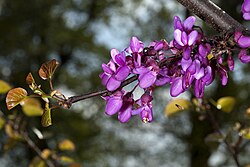| Cercidoideae Temporal range: | |
|---|---|
 | |
| Cercis siliquastrum | |
 | |
| Phanera variegata | |
| Scientific classification | |
| Kingdom: | Plantae |
| Clade: | Tracheophytes |
| Clade: | Angiosperms |
| Clade: | Eudicots |
| Clade: | Rosids |
| Order: | Fabales |
| Family: | Fabaceae |
| Subfamily: | Cercidoideae Legume Phylogeny Working Group [3] |
| Type genus | |
| Cercis L. | |
| Genera | |
See text | |
| Synonyms | |
| |
Cercidoideae is a subfamily in the pea family, Fabaceae. Well-known members include Cercis (redbuds), including species widely cultivated as ornamental trees in the United States and Europe, Bauhinia , widely cultivated as an ornamental tree in tropical Asia, and Tylosema , a semi-woody genus of Africa. The subfamily occupies a basal position within the Fabaceae and is supported as monophyletic in many molecular phylogenies. [4] [5] [6] [7] [8] [9] At the 6th International Legume Conference, the Legume Phylogeny Working Group proposed elevating the tribe Cercidae to the level of subfamily within the Leguminosae (Fabaceae). [10] The consensus agreed to the change, which was fully implemented in 2017. [3] It has the following clade-based definition:
Contents
The most inclusive crown clade containing Cercis canadensis L. and Bauhinia divaricata L. but not Poeppigia procera C.Presl, Duparquetia orchidacea Baill., or Bobgunnia fistuloides (Harms) J.H.Kirkbr. & Wiersema. [3]
Many genera show unique palynology. [11] [12]

